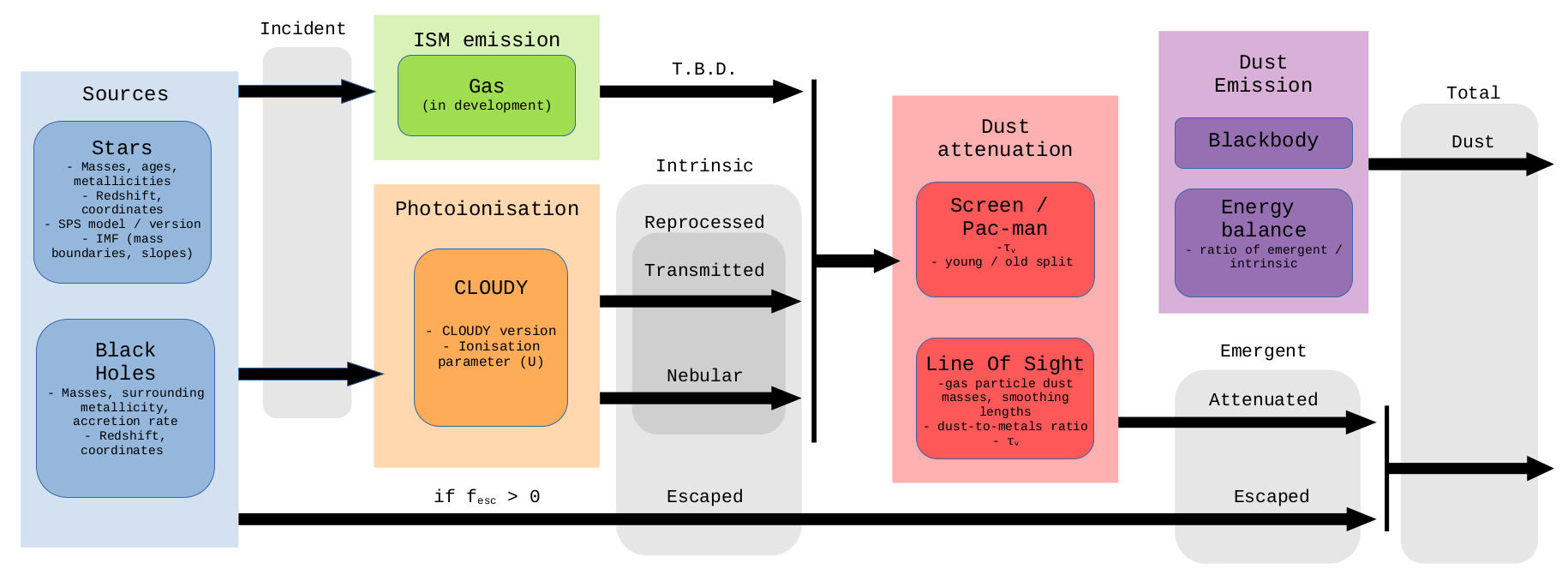Emission models¶
Overview¶
To simplify the calculation of complex emission, with many contributing components and different operations involved in their construction, synthesizer provides EmissionModels.
At their simplest, EmissionModels define the generation of a single type of spectra, e.g. the incident emission from a population of stars.
Hwoever, EmissionModels can be arbitrarily complex, defining multiple different types of spectra and lines from different components, and defining how they interact.
The possible operations that EmissionModels can define are:
Extraction of spectra / lines from a
Grid(see the grid docs).Generation of spectra, i.e. dust emission (see the dust emission docs) or AGN torus emission (see the AGN models docs).
Combination of spectra.
Attenuation of spectra with a dust curve (see the dust attenuation docs).
Any of these operations can be done in the presence of a mask, to apply the operation to a subset of the components contents (e.g. applying dust attenuation only to young stars). These masks can be applied identically to particle or parametric models.
Once an EmissionModel is constructed it can be used to generate spectra.
This is done by passing the EmissionMmodel to the get_spectra or get_lines method on a Galaxy or galaxy component.
This will then generate the spectra defined within the EmissionMmodel, given the properties of the Galaxy or component.
For more details see Generating spectra.
Named spectra¶
Synthesizer enables the generation of many different spectra which are associated with Galaxy objects or their components through EmissionModels.
These spectra are given standard labels that reflect their origin and the masks that have been applied (though custom labels can be provided).
The flowchart also shows how these different spectra are typically generated and related by an emission model.

Our standard naming system, which is used in the premade EmissionModels, is listed below.
incidentspectra are the spectra that serve as an input to the photoionisation modelling. In the context of stellar population synthesis these are the spectra that are produced by these codes and equivalent to the “pure stellar” spectra.transmittedspectra is the incident spectra that is transmitted through the gas in the photoionisation modelling. Functionally the main difference betweentransmittedandincidentis that thetransmittedhas little flux below the Lyman-limit, since this has been absorbed by the gas. This depends onfesc.nebularis the nebular continuum and line emission predicted by the photoionisation model. This depends onfesc.reprocessedis the emission which has been reprocessed by the gas. This is the sum ofnebularandtransmittedemission.escapedis the incident emission that escapes reprocessing by gas. This isfesc * incident. This is not subsequently affected by dust.intrinsicis the sum of theescapedandreprocessedemission, essentially the emission before dust attenuated.attenuatedis thereprocessedemission with attenuation by dust.emergentis the combined emission including dust attenuation and is the sum ofreprocessed_attenuatedandescaped. NOTE: this does not include thermal dust emission, so is only valid from the UV to near-IR.dust_emissionis the thermal dust emission calculated using an energy balance approach, and assuming a dust emission model.totalis the sum ofattenuatedanddust, i.e. it includes both the effect of dust attenuation and dust emission.For two component dust models (e.g. Charlot & Fall 2000 or
BimodalPacmanEmission) we also generate the individual spectra of the young and old component. This includesyoung_incident,young_nebular,young_attenuatedetc.youngandoldare equivalent tototalfor the young and old components.
All premade models follow these conventions and we encourage the user to employ the same system.
Working with EmissionModels¶
In the sections linked below we detail the basic functionality of an EmissionModel, the premade stellar and black hole emission models, dust emission generators, and how to customise a model or construct your own.